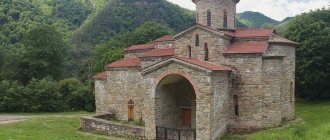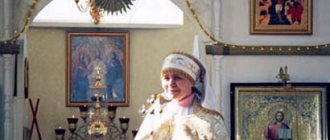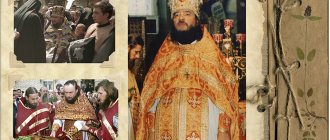- Reports and messages
- Story
- Saints in Rus'
There are many saints known in Rus', whose miracles still amaze the minds of their contemporaries.
One of the most famous saints in Rus' can be called Sergius of Radonezh. He is the founder of the Trinity Monastery (currently the Trinity - Sergius Lavra). Sergius did a lot for the prosperity of spiritual life. He was a man who sincerely loved his homeland and believed in spiritual kindness. Manuscripts of his associates have survived to this day, for example, “The Life of Sergius of Radonezh,” written by Epiphanius the Wise.
Seraphim of Sarov, an elder who lived in the mid-17th century. Even in early childhood, miracles often happened to the boy; once he could not resist and fell from the bell tower of the temple, which was the height of a three-story building. Everyone was amazed that such a fall did not leave even a scratch on the boy. After the fateful meeting of young Prokhor with the elder Dosifei, who showed the young man the path of life. Prokhor took monastic vows and became a minister of the Sarov Monastery, and his name also changed from Prokhor to Seraphim. One night the elder dreamed of the image of the Mother of God; she asked him to host people. Seraphim followed his dream, and soon people began to notice the miraculousness of the saint’s prayers. Some of his advice to people seemed strange at first, but following them later, they understood that the glory of the monk was righteous.
Blessed Matrona of Moscow, probably everyone knows about the miraculousness of the icon depicting the Matrona of Moscow; by touching the relics of the saint, even a barren person can give birth to a child, and a terminally ill person can receive healing. From early childhood, Matronushka was unable to see the images of God and the devil, but at the same time she was blind from birth. When the girl was 17 years old, trouble happened in their family, her mother’s legs gave out, doctors said that she would no longer be able to walk. Soon another misfortune overtook the girl; she had nowhere to live. And then she and other believers fell under the revolution over the saints, but she did not abandon the church. Prayer was a faithful companion in the difficult journey of life. After the revolution, sick, paralyzed and blind, she still continued to host people and instruct them on the path of God.
The icon with the image of Xenia of St. Petersburg helped more than one thousand people; the only thing with which the miraculousness of the icon can be compared is with the Matrona of Moscow. At the first stage, Ksenia’s life was no different from other people, it all started after the death of her beloved husband, the young woman became despondent, to some extent she blamed herself for the death of her husband, she even had thoughts of saying goodbye to life. One day, Ksenia left her house to poor people, and she herself went to live in an old dilapidated hut, completely abandoning worldly goods. For people, even of that time, this was a truly strange act. How exactly Ksenia came to serve the church is still not known; the only thing that is said in the manuscripts is that the gift of foresight was revealed after the fire. What subsequently led the woman to serving God.
4th grade
Religious activities
A few years later, a thriving temple of St. Sergius of Radonezh - the Trinity-Sergius Monastery - was formed in this place. Having learned about the establishment of the monastery, Ecumenical Patriarch Philotheus sent the abbot a letter in which he paid tribute to his activities. St. Sergius was a respected figure in princely circles: he blessed rulers before battles and tried them on among themselves.
In a brief biography of Radonezh, it is worth noting that throughout his life, the hieromonk of the Russian Church, in addition to the Trinity-Sergius, founded several more monasteries - Borisoglebsky, Blagoveshchensky, Staro-Golutvinsky, Georgievsky, Andronnikova and Simonov, Vysotsky.
The great hieromonk Sergius died on September 25, 1392.
son foretold
Ksenia, later known as Saint Blessed Xenia of Petersburg, was the wife of Colonel Andrei Fedorovich Petrov, who served as a court singer.
At twenty-six years old, Ksenia was widowed and seemed to have lost her mind from grief. She distributed her property to the poor, dressed in the clothes of her late husband and, as if forgetting her name, called herself by the name of her late husband - Andrei Fedorovich. In fact, the saint took upon herself the feat of foolishness for Christ's sake.
The saint did not have a permanent shelter, but wandered among the poor people of St. Petersburg, and at night she went into the field, where she spent time in fervent prayer.
Over time, people began to notice the grace-filled gifts that the Lord bestowed on the saint: Blessed Xenia often predicted the future, through her prayers the sick were healed, and people who followed her advice miraculously arranged their destiny.
There is a known case when Blessed Xenia took care of the welfare and salvation of an unborn baby. She once came to her old friend Paraskeva Antonova, to whom she gave her house, and said: “You’re sitting here darning your stockings, but you don’t know that God sent you a son! Go quickly to the Smolensk cemetery!” Paraskeva was very embarrassed by this absurdity, but she obeyed the blessed one and went.
Near the cemetery she saw a crowd of people and, approaching, learned that some cab driver had knocked down a pregnant woman. Here on earth, a woman gave birth to a boy, and she herself died. Everyone tried to find out who the woman was and where her relatives were, but they were unsuccessful.
Seeing the finger of God in what happened, Paraskeva took the boy to her, adopted him and raised him in all the rigor of Christian life. Her son supported his mother until a very old age and highly revered her. Paraskeva thanked God and God’s servant Ksenia for her command to accept her son.
Blessed Xenia labored in the feat of foolishness for about forty-five years; it can be argued that she departed to the Lord at the very beginning of the nineteenth century.
Interesting Facts
- The Life of Sergius tells that Bartholomew learned to read and write thanks to the blessing of the holy elder.
- Among the students of Sergius of Radonezh were such famous religious figures as Abraham of Galitsky, Pavel Obnorsky, Sergius of Nuromsky, Venerable Andronik, Pachomius of Nerekhta and many others.
- The life of the saint inspired many writers (N. Zernov, N. Kostomarov, L. Charskaya, G. Fedotov, K. Sluchevsky, etc.) to create works of art about his fate and deeds, including a number of books for children. The biography of Sergius of Radonezh is studied by schoolchildren in the 6th grade.
Pilgrimage on a demon to the Holy Land
In the 12th century, St. John happened to be one of the archbishops of Novgorod the Great.
From a young age he devoted himself to serving God. At first he served as a priest at the Church of St. Blaise, and later accepted monasticism with the name Elijah in the monastery he himself founded and, in 1165, was elevated to the episcopal department.
Through his prayers and the intercession of the Most Holy Theotokos, the miraculous salvation of Novgorod from the invasion of Suzdal took place in 1170. Taking care of the spiritual needs of his flock, the saint built seven churches in Novgorod, and was also very merciful and attentive to his flock, distinguished by meekness and unfeigned love.
One day, the holy Archbishop John was performing night prayer in his cell. And the demon got into his washbasin. Before washing, the saint crossed this vessel with water, and the demon could not come out of it. Then he prayed to the saint to let him out.
Saint John agreed, but on the condition that the demon would take him that same night to Jerusalem and bring him back. The evil one promised to fulfill the will of the miracle worker.
The demon took the form of a saddled horse, and the saint sat on it and was miraculously transported through the air to the Holy City. The saint of God commanded the demon to stand still, and he himself went to the Church of the Resurrection of Christ.
Approaching, he began to pray, and suddenly the locked doors of the temple opened in front of him, and candles and lamps were lit at the Holy Sepulcher. Having bowed to the shrine and fulfilled his desire, Saint John left the temple. John that same night returned to Novgorod on his improvised “horse”.
Later, the saint told this story to his flock, out of humility not saying that it happened to him and pointing out a certain ascetic. Then the demon began to slander the saint. He began to turn into a woman, and people saw a harlot coming out of John’s cell. Through demonic delusion, the eyes of visitors in his cell were presented with women's clothing and shoes.
The townspeople decided to expel Archbishop John from Novgorod, seized the saint and defamed him as a fornicator. He was taken to the Great Bridge on the Volkhve River and put on a raft to float out of the city down the river.
But the raft floated against the current, up the river to the monastery of St. George. Meanwhile, the saint prayed for the Novgorodians. Seeing this miracle, people realized that they had condemned Saint John in vain, out of demonic delusion, they repented and begged to return to the pulpit.
Before his death, the saint accepted the schema with his former name John and peacefully departed to the Lord on September 7, 1186, and in 1439 his incorruptible relics were found.
Lives of saints other than martyrologies
The literature of the “Lives of Saints” of the second kind - the venerables and others - is more extensive. The oldest collection of such tales is Dorothea, Bishop. Tyrian (+ 362), - a legend about the 70 apostles. Of the others, especially remarkable:
- “The Lives of Honest Monks”, Patriarch Timothy of Alexandria (+ 385);
- Lausaic Palladia, (“Historia Lausaica, s. paradisus de vitis patrum”;
- “Historia Christiana veterum Patrum” 1582, original text in ed. Renata Lavrentia;
- "Opera Maursii", Florence, 1746, vol. VIII; there is also a Russian translation, 1856);
- Works of Theodoret of Cyrrhus (+ 458) - (in the named edition of Renata) as well as in the complete works of Theodoret; in Russian translation - in “Works of St. Fathers", ed. Moscow spirit. Academy and previously separately);
- “Lemon garden, that is, a flower garden,” by John Mosch (Leimwnarion, in “Vitae patrum”, Rossveiga, Antv. 1628, vol. X; Russian edition - M. 1859).
In the West, the main writers of this kind during the patristic period were:
- Rufinus of Aquileia (“Vitae patrum s. historiae eremiticae”);
- John Cassian (“Collationes patrum in Scythia”);
- Gregory), bishop. Tours (died 594), who wrote a number of hagiographic works (“Gloria martyrum”, “Gloria confessorum”, “Vitae patrum”),
- Grigory Dvoeslov (“Dialogi” - Russian translation “An Interview on the Life of the Italian Fathers”, in “Orthodox Interlocutor” [2].
"Moral hagiography"
From v. a new feature appeared in the literature of the “Lives of the Saints” - a tendentious (moralizing, partly political-social) direction, decorating the story about the saint with fictions of fantasy. Among such hagiographers, the first place is occupied by Simeon Metaphrastus, a dignitary of the Byzantine court, who lived, according to some, in the 9th century, according to others in the 10th or 12th century. He published “The Lives of the Saints,” which constitute the most widespread primary source for subsequent writers of this kind not only in the East, but also in the West, among whom are Varaggio, Archbishop. Genoese, (+ 1298), who compiled the Golden Legend (“Legenda aurea sanctorum”) and Peter Natalibus, (+ 1382) - author of the Holy Catalog (“Catalogus Sanctorum”).
Subsequent editions take a more critical direction:
- Bonina Mombrizia, “Legendarium s. acta sanctorum" (1474);
- Aloysius Lippomana, bishop. Verona, “Vitae sanctorum” (1551 - 1560);
- Lawrence Surius, Cologne Carthusian, “Vitae sanctorum orientis et occidentis” (1664);
- George Vicella, “Hagiologium s. de sanctis ecclesiae";
- Ambrose Flaccus, “Fastorum sanctorum libri XII”;
- Renata Laurentia de la Barre - “Historia Christiana veterum patrum”;
- C. Baronia, “Annales ecclesiast.”;
- Rosweida - “Vitae patrum”;
- Radera, “Viridarium sanctorum ex minaeis graecis” (1604).
Miraculous rescue from captivity by the great martyr
The Holy Great Martyr George the Victorious has always been considered the patron saint of the Orthodox army and was especially revered by military personnel.
The saint was born in the 2nd century, in Cappadocia (Asia Minor), into a deeply religious Christian family. His father suffered martyrdom for Christ when George was still a child, and his mother, who owned estates in Palestine, moved with her son to her homeland and raised him in strict piety.
In his youth, he enlisted in the Roman army, where he proved himself to be a courageous warrior and was noticed and approached by Emperor Diocletian.
The pagan emperor especially hated Christians and persecuted them. Saint George, having learned about the emperor’s decision, distributed his inheritance to the poor, set his slaves free, appeared in the Senate and professed himself a Christian.
The enraged Diocletian ordered George to be subjected to the most sophisticated torture. They wheeled the great martyr on the wheel, covered him in a pit with quicklime, put him in iron boots with nails, beat him with ox sinews and subjected him to other tortures, but each time Saint George was miraculously healed by God.
Finally, on April 23, 303, the holy Great Martyr George was beheaded with a sword. But even after his death, his miracles and exploits did not stop, but only intensified. So, once in a certain area he saved a noble maiden from death by killing a serpent with a spear - a terrible monster to which the locals made human sacrifices. This feat is depicted on Russian kopeks and in the coat of arms of Moscow.
But the miracles of St. George continue to this day. One of them happened at the beginning of the 20th century during the First World War, as evidenced by George Koktsidis from the city of Drama:
“My father Anastasius Koktsidis was born in 1884 in the Pontic village of Yazlakioi, located 35 kilometers from Amiso (Sampsunta). He had seven children.
In 1914, general mobilization was announced in connection with the outbreak of the Russian-Turkish War. The father did not want to fight for the Turks against Russia and went to the mountains with his family. Until 1922 he remained in the partisan detachment of Captain Christos Avraamidis.
He did not have time to escape to Greece; he was caught by the Turkish authorities and placed in solitary confinement. He was in constant fear. One day suddenly something flashed like lightning and some noise was heard.
"Forward!" - these were the first words that my father heard when he woke up. Before him stood St. George the Victorious, a saint whom he especially revered. The father saw that the path was open before him. So he left the camp. There was complete silence around. With a quick step, the father reached a populated area at dawn. I got my bearings and was able to find my family.
Dad often talked about his salvation and always emphasized that everything happened not in a dream, but in reality.”
The bear fed from the hand of Flame
The Monk Seraphim of Sarov, especially revered in Russia, lived for a long time in solitude, the place of which he chose the Volga forests.
From childhood, the pious youth Prokhor was marked by the special patronage of the Most Holy Theotokos, who saved his life when he fell from a bell tower under construction. Prokhor always loved prayer very much and strove for the monastic life. In his youth, he entered the Sarov Monastery and accepted the priesthood.
After some time, the saint decided to become a hermit and went into the forests. For about three and a half years, the Reverend Father Seraphim ate only one herb, which grew around his cell. He spent a thousand days and a thousand nights in the feat of pillar-building on a stone boulder. They say that the old man in his solitude was visited by birds and wild animals.
He called the clearing and his cell on it “desert”, in memory of the hermits who lived in the desert. The miracle worker Seraphim gave his love to every living creature, be it human or animal. “My joy,” he addressed everyone who came to him.
A bear often visited the saint’s forest “desert.” Father Seraphim treated him like a meek lamb, and fed him bread from his hands, and the proud owner of the forest accepted the treat, presenting his huge head for affection and, contented, lay down at the feet of the old man, like a faithful dog.
“The Lord sent me a beast as a consolation!” said Saint Seraphim, stroking the bear’s shaggy skin.
One day one of the nuns, who came to the elder for advice, saw this and was amazed by the miracle. And he said to her: “Do you remember, mother, a lion served the Monk Gerasim on the Jordan, and a bear served poor Seraphim (as he humbly called himself).”
Other hagiographic works in the West
Individuals in the West continued to publish the lives of saints simultaneously with the Bollandist corporation. Of these, worthy of mention:
- Abbot Commanuel, “Nouvelles vies de saints pour tous le jours” (1701);
- Ballier, “Vie des saints” (work strictly critical),
- Arnaud d'Andili, "Les vies des peres des deserts d'Orient" (1771).
Among the newest Western publications, the Lives of the Saints deserves attention. Stadler and Heim, written in dictionary form: “Heiligen Lexicon”, (1855).






